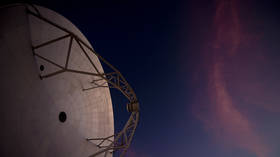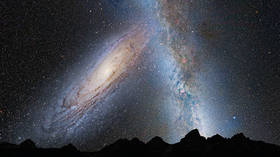‘Cosmic yeti’: Scientists discover ‘invisible’ missing-link galaxy from the early universe

Astronomers in the US and Australia say they have discovered a "cosmic Yeti" galaxy hiding out in a distant corner of the universe. The light from this galaxy is believed to have taken 12.5 billion years to reach us.
Christina Williams spotted the elusive “missing link” galaxy in observations from the Atacama Large Millimeter Array in Chile (ALMA). A visualization produced by the University shows the warm glow of dust particles heated by stars forming deep inside a young galaxy.
“It was very mysterious because the light seemed not to be linked to any known galaxy at all,” said Williams, a National Science Foundation postdoctoral fellow at the Steward Observatory. “When I saw this galaxy was invisible at any other wavelength, I got really excited because it meant that it was probably really far away and hidden by clouds of dust.”
Also on rt.com Black hole caught flickering violently WITHIN our galaxyMuch like a bigfoot or yeti, such massive galaxies have been long rumored in the scientific community, but proved hard to pin down, photograph, and measure in all their glory. In this particular case, an added difficulty was the giant dust clouds concealing light from the stars within, rendering it almost invisible to those searching for it.
"Like a cosmic Yeti, the scientific community generally regarded these galaxies as folklore, given the lack of evidence of their existence," the university said in a statement.
This particular abominable astronomical behemoth boasts as many stars as our own Milky Way galaxy, but forms new stars at a rate roughly one hundred times faster, according to study co-author Ivo Labbé with the Swinburne University of Technology in Australia.
The team published its findings on Tuesday in The Astrophysical Journal.
Also on rt.com Running out of time? Earth could meet its end if Milky Way is ‘eaten’ by another galaxy… in 4.5 billion yearsObservations of such a massive galaxy help better our understanding of galactic formation in the early days of the universe, however, more research and analysis is required to determine whether this is indeed a massive 'hermit' galaxy or is instead a pack of 'Yeti' galaxies.
NASA's long-anticipated and much-delayed James Webb Space Telescope is expected to help answer such questions when it finally comes online in March 2021.
Think your friends would be interested? Share this story!














